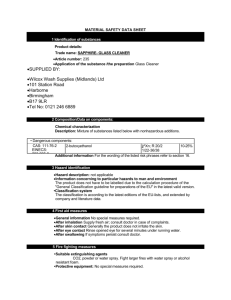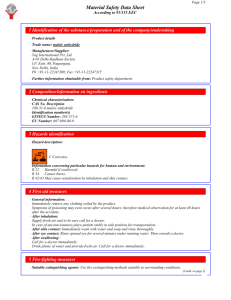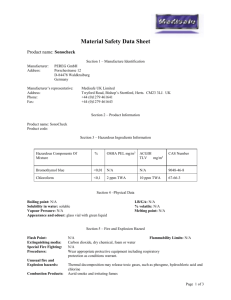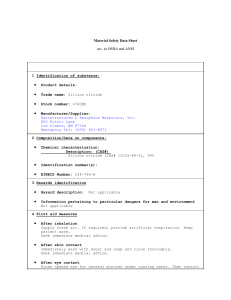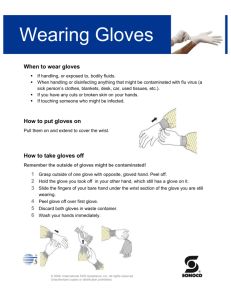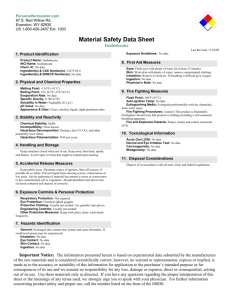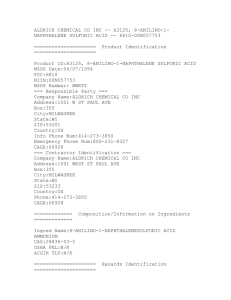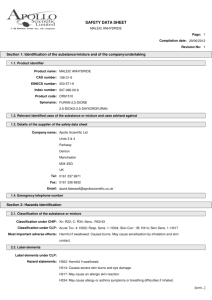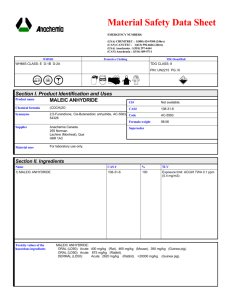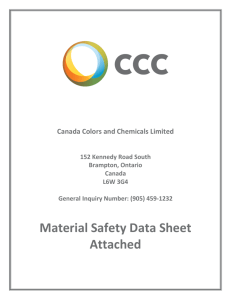Maleic anhydride
advertisement
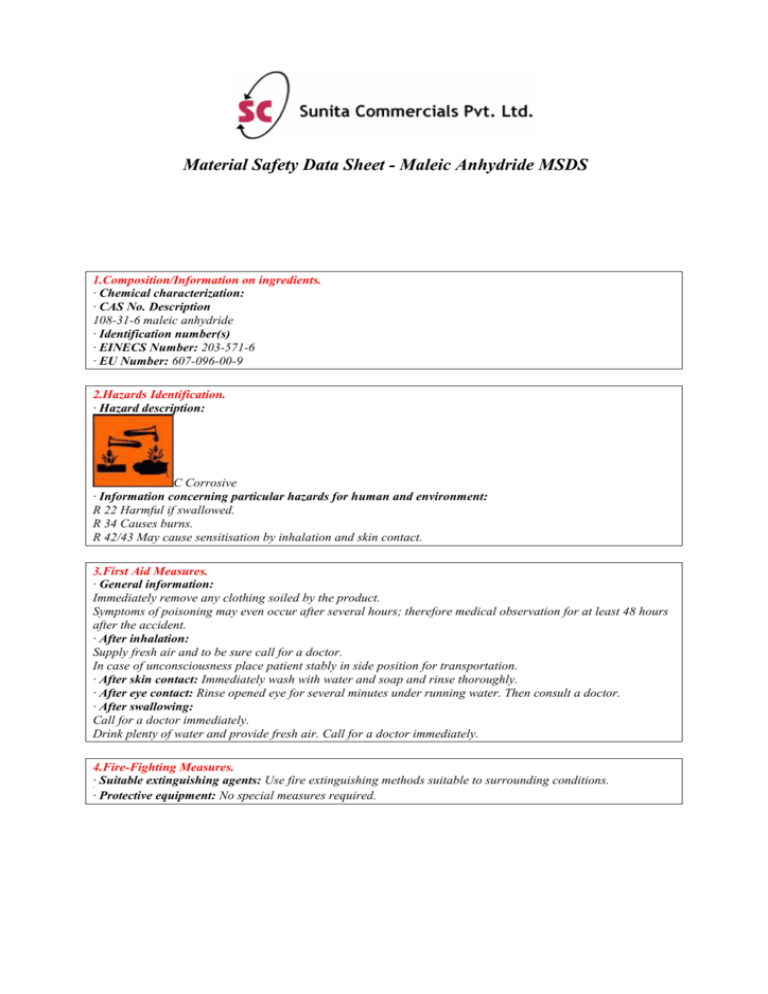
Material Safety Data Sheet - Maleic Anhydride MSDS 1.Composition/Information on ingredients. · Chemical characterization: · CAS No. Description 108-31-6 maleic anhydride · Identification number(s) · EINECS Number: 203-571-6 · EU Number: 607-096-00-9 3 Hazards identification 2.Hazards Identification. · Hazard description: C Corrosive · Information concerning particular hazards for human and environment: R 22 Harmful if swallowed. R 34 Causes burns. R 42/43 May cause sensitisation by inhalation and skin contact. 4 First aid measures 3.First Aid Measures. · General information: Immediately remove any clothing soiled by the product. Symptoms of poisoning may even occur after several hours; therefore medical observation for at least 48 hours after the accident. · After inhalation: Supply fresh air and to be sure call for a doctor. In case of unconsciousness place patient stably in side position for transportation. · After skin contact: Immediately wash with water and soap and rinse thoroughly. · After eye contact: Rinse opened eye for several minutes under running water. Then consult a doctor. · After swallowing: Call for a doctor immediately. Drink plenty of water and provide fresh air. Call for a doctor immediately. 5 Fire-fighting measures 4.Fire-Fighting Measures. · Suitable extinguishing agents: Use fire extinguishing methods suitable to surrounding conditions. · Protective equipment: No special measures required. DR 6 Accidental release measures 5.Accident Release Measures. · Person-related safety precautions: Wear protective equipment. Keep unprotected persons away. · Measures for environmental protection: Do not allow to enter sewers/ surface or ground water. · Measures for cleaning/collecting: Use neutralizing agent./Dispose contaminated material as waste according to item 13. Ensure adequate ventilation. 7 Handling and storage 6.Handling & Storage. · Handling: · Information for safe handling: Thorough dedusting. Ensure good ventilation/exhaustion at the workplace. Prevent formation of dust. · Information about fire - and explosion protection: No special measures required. · Storage: · Requirements to be met by storerooms and receptacles: No special requirements. · Information about storage in one common storage facility: Not required. · Further information about storage conditions: Keep container tightly sealed. 8 Exposure controls/personal protection 7.Exposure Control/Personal Protection · Additional information about design of technical facilities: No further data; see item 7. · Ingredients with limit values that require monitoring at the workplace: 108-31-6 maleic anhydride PEL (USA)------------------------------------------- 1 mg/m³, 0.25 ppm REL (USA)------------------------------------------ 1 mg/m³, 0.25 ppm TLV (USA)------------------------------------------ 0.4 mg/m³, 0.1 ppm SEN WEL (Great Britain)----------------------------- Short-term value: 3 mg/m³ Long-term value: 1 mg/m³ · Additional information: The lists valid during the making were used as basis. · Personal protective equipment: · General protective and hygienic measures: Keep away from foodstuffs, beverages and feed. Immediately remove all soiled and contaminated clothing Wash hands before breaks and at the end of work. Avoid contact with the eyes and skin. · Respiratory protection: In case of brief exposure or low pollution use respiratory filter device. In case of intensive or longer exposure use self-contained respiratory protective device. · Protection of hands: Protective gloves The glove material has to be impermeable and resistant to the product/ the substance/ the preparation. Due to missing tests no recommendation to the glove material can be given for the product/ the preparation/ the chemical mixture. Selection of the glove material on consideration of the penetration times, rates of diffusion and the degradation · Material of gloves The selection of the suitable gloves does not only depend on the material, but also on further marks of quality and varies from manufacturer to manufacturer. · Penetration time of glove material The exact break trough time has to be found out by the manufacturer of the protective gloves and has to be observed. · Eye protection: Tightly sealed goggles DR 9 Physical and chemical properties 8.Physical and Chemical Properties. · General Information Form: Solid Colour: White Odour: Characteristic · Change in condition Melting point/Melting range: 52.6°C Boiling point/Boiling range: 202°C · Flash point: 103°C · Flammability (solid, gaseous): Product is not flammable. · Ignition temperature: 380°C · Danger of explosion: Product does not present an explosion hazard. · Explosion limits: Lower: 1.4 Vol % Upper: 7.1 Vol % · Vapour pressure at 20°C: 0.2 hPa · Density at 20°C: 1.48 g/cm³ · Solubility in / Miscibility with water at 20°C: 788 g/l 10 Stability and reactivity 9.Stability and Reactivity. · Thermal decomposition / conditions to be avoided: No decomposition if used according to specifications. · Dangerous reactions No dangerous reactions known. · Dangerous decomposition products: No dangerous decomposition products known. 10.Toxilogical Information. · Acute toxicity: · LD/LC50 values relevant for classification: Oral--------------------------------------LD50---------------------- 400 mg/kg (rat) Dermal--------------------------------- LD50---------------------- 2620 mg/kg (rabbit) · Primary irritant effect: · on the skin: Caustic effect on skin and mucous membranes. · on the eye: Strong caustic effect. · Sensitization: Sensitization possible through inhalation. Sensitization possible through skin contact. · Additional toxicological information: Swallowing will lead to a strong caustic effect on mouth and throat and to the danger of perforation of esophagus and stomach. 12 Ecological information 11.Ecological Information. · General notes: Water hazard class 1 (German Regulation) (Assessment by list): slightly hazardous for water Do not allow undiluted product or large quantities of it to reach ground water, water course or sewage system. Must not reach sewage water or drainage ditch undiluted or unneutralized. 13 Disposal considerations 12.Disposal Consideration. · Product: · Recommendation Must not be disposed together with household garbage. Do not allow product to reach sewage system. · Uncleaned packaging: · Recommendation: Disposal must be made according to official regulations.
